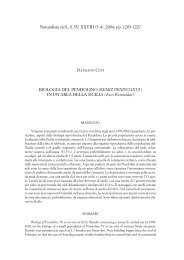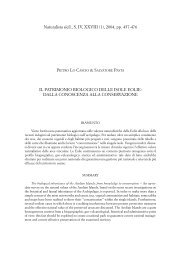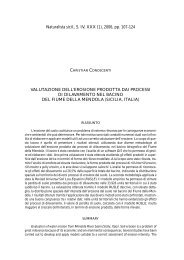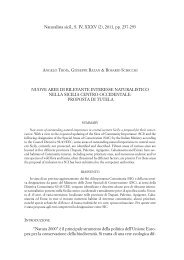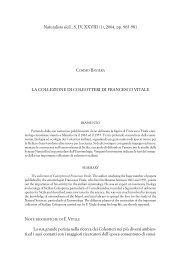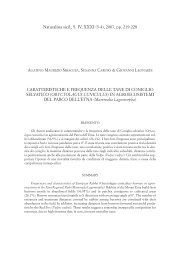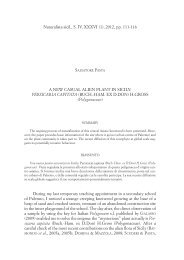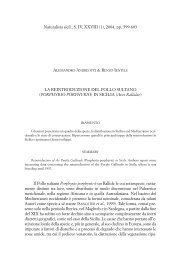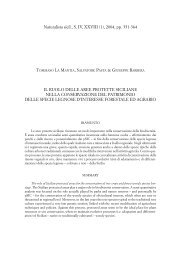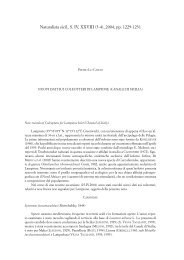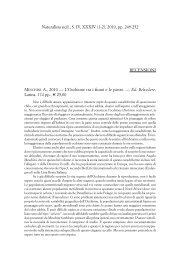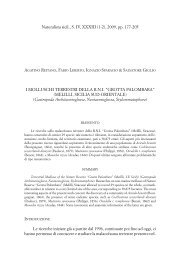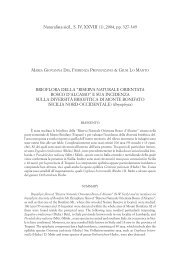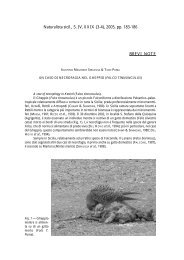2007,pp - Società Siciliana di Scienze Naturali
2007,pp - Società Siciliana di Scienze Naturali
2007,pp - Società Siciliana di Scienze Naturali
You also want an ePaper? Increase the reach of your titles
YUMPU automatically turns print PDFs into web optimized ePapers that Google loves.
Gall midges (Diptera Cecidomyiidae) of Sicily<br />
271<br />
whole shoot on which all flower buds are changed into small galls, each with<br />
one larva inside (Pl. III, Fig. 13). Occurrence: not much abundant. It was<br />
recently found at Trapani saltpans, Catania seafront, Capodarso (Caltanissetta)<br />
(leg. B. Massa) and Siculiana Marina (Agrigento) (leg. A. Troìa). DE<br />
STEFANI (1905a) obtained one Braconid parasitoid in April from galls of this<br />
species. Type-locality: Sciacca and Marsala (DE STEFANI, 1900). Reference:<br />
TROTTER & CECCONI (1900-1917: N. 215), Trapani, 1901, leg. De Stefani;<br />
Trapani and Palermo (DE STEFANI, 1906c). Distribution: Me<strong>di</strong>terranean.<br />
Asphondylia coronillae (Vallot, 1829)<br />
Larvae develop in swollen buds or deformed pods of Coronilla<br />
emeroides Boiss. et Spruner (Fabaceae) (Pl. VIII, Fig. 46). Occurrence: bud<br />
galls were collected at Zucco (Cinisi, Palermo), loc. F. Nocella and adults<br />
emerged on 4.4.2000 (1 male, 1 female), leg. R. Lo Duca. New record for<br />
Sicily. Distribution: Me<strong>di</strong>terranean.<br />
Asphondylia genna<strong>di</strong>i (Marchal, 1904)<br />
Syn. Eumarchalia genna<strong>di</strong>osi Del Guercio, 1918; Cecidomyia ceratoniae Bevan, 1918; Asphondylia<br />
capsici Barnes, 1932<br />
MARCHAL (1904) described this species very briefly based on material<br />
sent to him from Cyprus by P. Genna<strong>di</strong>us. Larvae develop in pods of Ceratonia<br />
siliqua L. (Fabaceae) and cause their misshapen and deformation,<br />
attacked fruits remain small and become brown (Pl. VIII, Fig. 47). It is a pest<br />
of carob causing <strong>di</strong>sease so called “brachycarpia”. GAGNÉ & ORPHANIDES<br />
(1992) considered A. genna<strong>di</strong>i to be a polyphagous species with alternation of<br />
host plant species. Occurrence: LONGO (1996) reports the presence of this<br />
species on Ca<strong>pp</strong>aris s<strong>pp</strong>. in central-southern Italy and Sicily, mainly in<br />
autumn; PERI et al. (2006) record its presence on Salina, Vulcano, Lipari<br />
(Eolian Is.), Ustica, Favignana, Levanzo (Ega<strong>di</strong> Is.), Pantelleria and Linosa on<br />
Ca<strong>pp</strong>aris spinosa L. They write that it is present on the Pantelleria Is. all over<br />
the year, inducing galls from autumn to spring within Ceratonia siliqua<br />
carobs, in spring whitin Calicotome spinosa legumes and finally in summer on<br />
Ca<strong>pp</strong>aris spinosa inflorescences. Systematics of Asphondylia are very <strong>di</strong>fficult<br />
and further detailed stu<strong>di</strong>es are necessary (UECHI et al., 2004). Distribution:<br />
Me<strong>di</strong>terranean, reaching up to Turkey (SKUHRAVÁ et al., 2005).<br />
Asphondylia menthae Kieffer, 1901<br />
A single larva develops in swollen flower bud of Mentha s<strong>pp</strong>. (Lamiaceae).<br />
Occurrence: DE STEFANI (1898a, 1905a, 1906c) found galls of this species and<br />
their parasitoids in September at Palermo. Distribution: Me<strong>di</strong>terranean.



